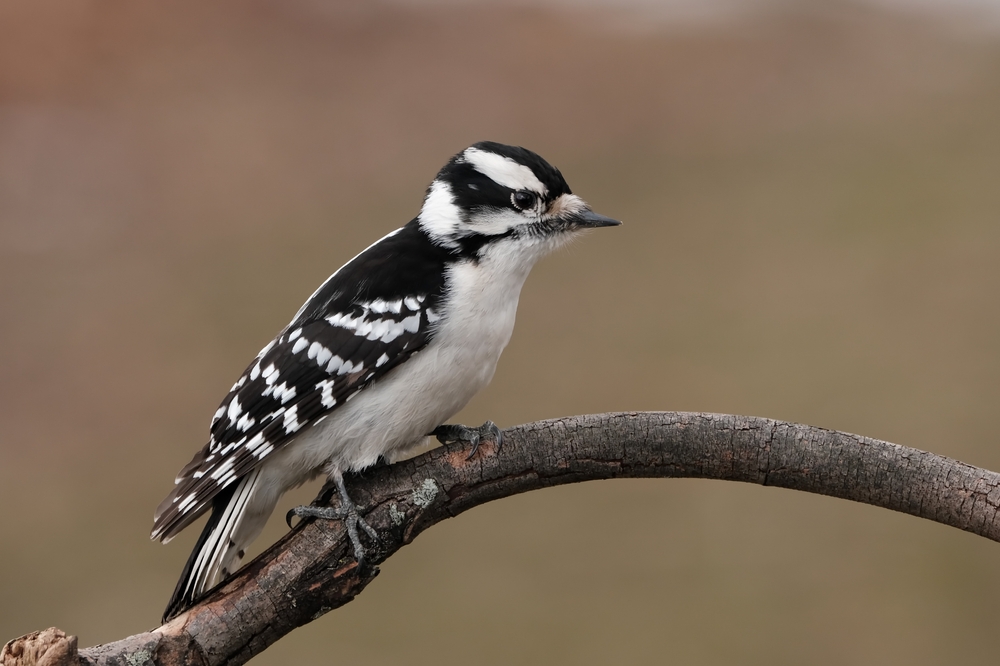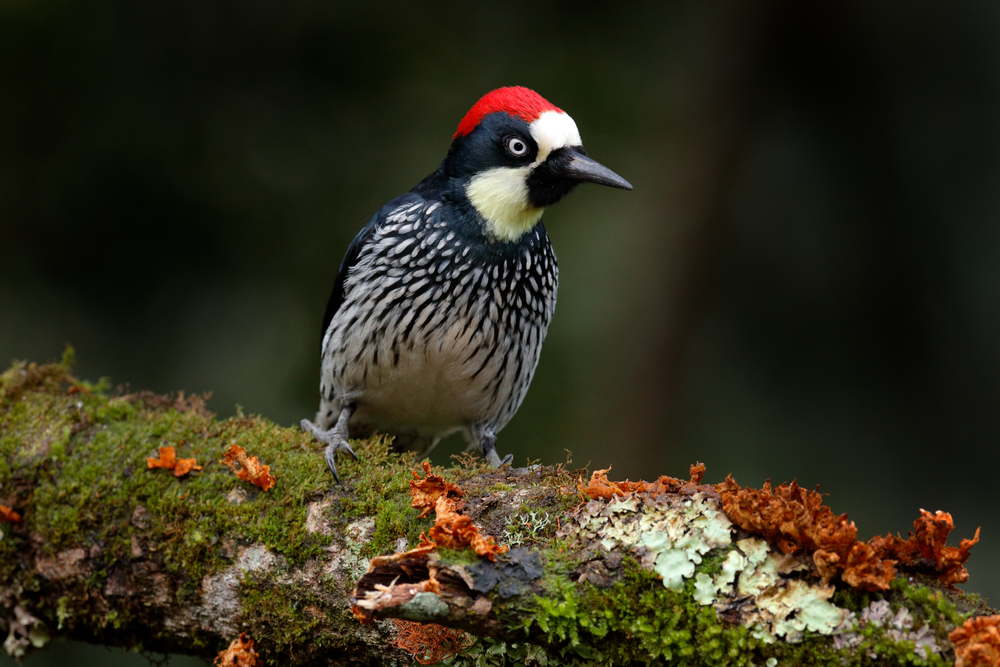The Downy Woodpecker (Dryobates pubescens) is closely related to the Hairy Woodpecker (Dryobates villosus). The two species look nearly identical, but the Downy is smaller with a shorter beak and wings.
About
The Downy Woodpecker (Dryobates pubescens), part of the Picidae family, is the smallest woodpecker species in North America. Found throughout forests, woodlands, parks, and even suburban backyards, this adaptable bird is a familiar and energetic presence across much of the continent.
Measuring only 14–17 cm (5.5–6.7 in) in length with a wingspan of 25–30 cm (10–12 in), the Downy Woodpecker is compact and agile. Its plumage is strikingly patterned: black wings with white spots, a white underside, and a broad white stripe down the back. Males are distinguished by a small red patch on the back of the head, while females lack this marking. Its short, chisel-like bill is proportionately smaller than those of most woodpeckers, giving it a delicate appearance compared to its larger relatives.
The Downy Woodpecker’s diet is varied but consists mainly of insects such as beetle larvae, ants, and caterpillars, which it extracts from bark and wood using its sharp bill and barbed tongue. It also feeds on seeds, berries, and tree sap, and readily visits backyard feeders for suet, sunflower seeds, and peanuts. This adaptability to both wild and human-modified environments has helped it remain widespread and abundant.
Breeding occurs in tree cavities excavated by the pair, usually in dead or decaying wood. The female lays 3–8 eggs, and both parents take turns incubating and feeding the chicks. Young fledge after about three weeks but may stay with the parents for a short period afterward.
Non-migratory, the Downy Woodpecker remains year-round across its range, enduring harsh winters by relying on food caches and feeders. Its cheerful tapping, energetic foraging, and high-pitched calls make it a welcome sight in woodlands and backyards alike, symbolizing resilience and adaptability in North American birdlife.
Physical Characteristics
The Downy Woodpecker is the smallest woodpecker species in North America, with a compact build and distinctive black-and-white plumage:
Head and Face:
They have a white face with bold black stripes and a white patch down the center of the back. Males display a small red patch on the back of the head, while females lack this marking.
Beak:
Their beak is short, straight, and chisel-like, proportionally smaller than that of most woodpeckers, but perfectly adapted for drilling into bark to extract insects.
Plumage:
The plumage is black and white, with white underparts, black wings marked with white spots, and a clean white back. The tail is black with white outer feathers that show black spots.
Body and Build:
They have a compact body, stiff tail feathers for support while climbing, and zygodactyl feet (two toes forward, two backward) that help them cling to tree bark.
Size:
-
Length: 5.5 to 6.7 in (14 to 17 cm)
-
Wingspan: 9.8 to 11.8 in (25 to 30 cm)
-
Weight: 0.7 to 1.0 oz (20 to 28 g)
The Downy Woodpecker’s small size, short beak, and contrasting black-and-white plumage make it a highly recognizable and agile member of North America’s woodlands, parks, and gardens.
Reproduction
The reproductive cycle of the Downy Woodpecker follows the typical pattern of cavity-nesting woodpeckers, with both parents playing an active role:
1. Courtship and Pair Formation:
Courtship begins in late winter to early spring. Males attract females through drumming displays, calling, and showing potential nest sites. Once paired, they remain monogamous for the breeding season.
2. Breeding Season:
Breeding generally occurs from April to July, depending on latitude and climate.
3. Nesting:
Pairs excavate nest cavities in dead or decaying trees, fence posts, or wooden structures. Cavities are typically 6 to 12 in (15 to 30 cm) deep and lined with wood chips.
4. Egg Laying:
The female lays 3 to 8 white eggs. Both parents share incubation duties.
5. Incubation:
Incubation lasts 12 days, with males often taking the night shift while females incubate during the day.
6. Chick Development:
Chicks hatch naked and blind, fully dependent on their parents. They are fed insects delivered directly into the nest cavity.
7. Fledging and Independence:
Young fledge at about 18 to 21 days of age but may remain near their parents for several weeks while learning to forage.
The Downy Woodpecker’s cooperative parenting and use of tree cavities provide safety for their young, ensuring strong survival rates despite their small size.
Lifespan
The Downy Woodpecker is a hardy little bird, though its survival depends on habitat quality and predation pressures.
Lifespan in the Wild:
In their natural woodland and suburban habitats, Downy Woodpeckers typically live 2 to 5 years on average, though some individuals can survive up to 11 years. High mortality in the first year reduces overall life expectancy.
Lifespan in Captivity:
When provided consistent food, shelter, and protection from predators, Downy Woodpeckers can live longer, sometimes reaching 12+ years under human care.
Threats to the Downy Woodpecker:
-
Predation: Eggs and chicks are vulnerable to snakes, squirrels, and other birds. Adults are preyed upon by hawks and owls.
-
Harsh Winters: Severe weather and food shortages can lower survival rates, especially for juveniles.
-
Habitat Loss: Removal of dead trees and snags reduces nesting opportunities.
-
Competition: They face competition from larger woodpeckers and cavity-nesting birds like starlings.
Despite their small size, Downy Woodpeckers are resilient, and their adaptability to human-altered landscapes, such as parks and gardens, helps sustain healthy populations across North America.
Eating Habits
The Downy Woodpecker has a versatile diet and feeding strategy, allowing it to thrive in diverse habitats:
Diet:
They feed primarily on insects, including beetle larvae, ants, caterpillars, and other wood-boring insects. They also consume plant materials such as seeds, berries, and tree sap. In winter, they frequently visit bird feeders for suet, sunflower seeds, and peanuts.
Feeding Strategy:
Like other woodpeckers, they probe bark and wood by pecking and drilling to extract insects. They are especially skilled at gleaning insects from twigs, stems, and even weed stalks, enabling them to exploit food sources too small for larger woodpeckers.
Role in Ecosystem:
By controlling insect populations, especially wood-boring pests, they provide a natural form of pest management for forests and human environments.
Social Feeding Behavior:
Generally solitary foragers, Downy Woodpeckers may join mixed-species flocks in winter, where they benefit from safety in numbers and increased foraging efficiency.
Feeding Technique:
They use their chisel-like beak to tap into wood, then extend their long, barbed tongue to capture insects. They also occasionally lap sap from holes drilled by sapsuckers.
The Downy Woodpecker’s small size and flexible feeding habits allow it to occupy niches unavailable to larger woodpeckers, making it one of the most adaptable insect-eating birds in North America.
Uniqueness
The Downy Woodpecker (Dryobates pubescens) is one of the most familiar and widespread woodpeckers in North America, with several traits that make it distinctive:
Smallest North American Woodpecker:
As the tiniest woodpecker on the continent, its small size allows it to forage on stems, twigs, and weed stalks too delicate for larger woodpeckers.
Look-alike Species:
It closely resembles the larger Hairy Woodpecker but can be distinguished by its smaller size, shorter bill, and proportionally shorter wings.
Adaptability:
Downy Woodpeckers thrive in a wide range of habitats, from forests and orchards to suburban gardens and parks, and they readily visit backyard feeders.
Unique Foraging Style:
Unlike many woodpeckers that focus on large trees, Downy Woodpeckers frequently forage on fine branches and even plant stems, giving them access to insect prey unavailable to other species.
Seasonal Flexibility:
Their diet shifts with the seasons—mostly insects in summer, but seeds, berries, and suet in winter—making them highly versatile feeders.
Role in Mixed Flocks:
In winter, they often join mixed-species flocks of chickadees, nuthatches, and other small birds, benefiting from shared vigilance and increased feeding opportunities.
The Downy Woodpecker’s small size, adaptability, and frequent presence in backyards make it one of the most recognizable and approachable woodpeckers in North America.
Be the First to Share Photos of This Species.
FAQ’s
1. What species is closest to the Downy Woodpecker?
2. How does the Downy Woodpecker compare to other woodpeckers?
It is the smallest woodpecker in North America, more agile on twigs and stems than larger species. While Hairy and Pileated Woodpeckers favor big trees, the Downy specializes in foraging on small branches and even weeds, giving it access to food others can’t reach.
3. What national parks provide the best opportunity to see a Downy Woodpecker?
Downy Woodpeckers are widespread across much of North America. Some of the best national parks to spot them include:
-
Yellowstone National Park, USA
-
Great Smoky Mountains National Park, USA
-
Acadia National Park, USA
-
Everglades National Park, USA
-
Banff National Park, Canada
Their adaptability to forests, woodlands, and even developed areas makes them one of the most commonly encountered woodpeckers in these parks.




































































